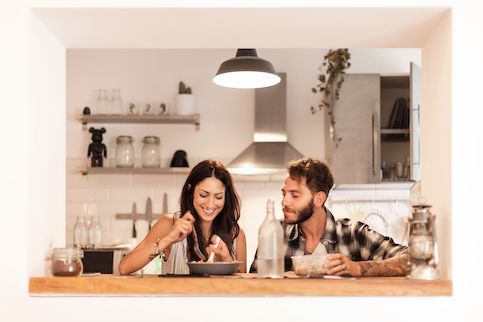When inflation is on the rise, it’s more expensive to purchase goods and services. But the effects of inflation don’t stop with higher prices pinching shoppers’ wallets. Here are seven effects rising inflation has on the economy.
Key Takeaways:
- Inflation can increase home prices and interest rates – bad news for buyers but good news for homeowners and sellers.
- Inflation is the rate at which prices increase over time – typically a year.
- Factors contributing to increased inflation include increased production costs, higher demand, the housing market and monetary policy.
What Is Inflation?
The U.S. Department of Labor defines inflation as a “general upward price movement of goods and services in an economy.” In other words, goods and services get more expensive as the cost of production increases. Inflation is a broad measure of how much the cost of living is rising over time – typically, it’s measured year by year.
Economists measure inflation by tracking the cost of specific goods and services. Government agencies measure the cost of living by surveying households to determine how much they pay for everyday items. This data is used to calculate the consumer price index.
The percentage change in the CPI over time is called consumer price inflation, the primary figure used to measure inflation. It’s measured against itself to determine inflation over a specific time. For example, if the base year CPI is 100 and the current year CPI is 115, then inflation is 15% over that time.
What’s Your Goal?
Buy A Home
Discover mortgage options that fit your unique financial needs.

Refinance
Refinance your mortgage to have more money for what matters.
Tap Into Equity
Use your home’s equity and unlock cash to achieve your goals.
5 Causes Of Inflation
Many factors contribute to inflation, but a primary cause is an imbalance in supply and demand. For example, limited fuel supplies lead to higher gas prices if demand stays the same. A relaxed monetary policy that circulates more currency than the economy can support can also increase inflation.
In the early 1980s, the U.S. experienced a period of significant inflation in response to a global energy crisis. High inflation rates prompted the Federal Reserve to raise interest rates, culminating in the highest historical mortgage rate on Oct. 9, 1981, when the average interest rate on 30-year fixed-rate mortgages was 18.63%.
1. Cost-Push Inflation
Cost-push inflation occurs when the cost of production rises and there’s not enough supply to meet the demand, causing prices to rise.
During the COVID-19 pandemic, high-demand products were in short supply, inflating prices across the economy. For example, the limited supply of lumber made it more expensive to buy, which in turn made it more difficult to build a house for cheap.
The Federal Reserve Bank of New York found that 40% of the higher prices between 2019 and 2021 were caused by supply-side issues. The war in Ukraine further affected inflation, causing a surge in the cost of fuel and food around the world.
2. Demand-Pull Inflation
On the other side of the coin is demand-side inflation. When demand for an item increases significantly and supply remains the same, prices will increase.
The New York Fed’s analysis found that 60% of the higher prices between 2019 and 2021 were due to demand-side issues. This was partially fueled by the government setting a looser monetary policy at the onset of the pandemic to reduce the likelihood of a recession.
As COVID-19 restrictions lifted, demand increased in sectors such as travel and entertainment. As a result, suppliers that scaled back spending in these sectors needed to offer higher wages and rehire workers, increasing prices for those services.
3. Built-In Inflation
Also known as a wage-price spiral, built-in inflation occurs when increases in the cost of living prompt workers to demand higher wages. Businesses have to raise prices to afford paying higher wages to attract and retain workers, which further increases the cost of living. This creates a self-feeding loop of prices increasing wages and wages increasing prices.
4. Housing Market
Housing prices are hugely important in measuring inflation in the economy because housing costs take up a large portion of the average household budget. When inflation increases, home sellers typically increase their asking prices. If construction materials become more expensive, new homes cost more to build. This can reduce the supply of homes on the market, which increases prices. At the same time, fewer borrowers can afford to buy a home, which reduces demand.
5. Monetary Policy
Governments monitor inflation closely so that they can adjust fiscal policy to keep the economy stable. For example, the Fed may cut the federal funds rate to stimulate the economy. The government also may cut taxes or fund infrastructure projects to stimulate the economy. On the other hand, the Fed might increase interest rates to tame inflation. This is all in the interest of keeping the economy balanced. If the money supply grows too big relative to the economy, the value of currency decreases, and inflation increases.
Ready To Become A Homeowner?
Get matched with a lender that can help you find the right mortgage.
7 Effects Of Inflation On The Economy
What are the effects of inflation? Here are seven ways the effect of inflation affects the overall economy.
1. Lost Purchasing Power
One of the most obvious impacts of inflation is the loss of purchasing power, which is how much you can buy with your money. As purchasing power erodes, many feel the impact on their budget. However, those with low or fixed incomes often feel the effect the most. As inflation takes hold, it’s important to monitor how well your income keeps pace with the changes. If it’s within your power, negotiate for a raise or switch up your income streams to keep up with rising costs.
2. Interest Rates Increase
The Fed has a relatively limited toolkit to tame inflation. The option it commonly turns to first is raising interest rates. As the Fed pushes interest rates higher, borrowing money becomes more expensive. The average consumer takes advantage of borrowing to make major purchases – like a home or vehicle – a reality. This means rising interest rates affect household purchases across the country. If you have any debt with a variable interest rate, you’ll face higher costs as your interest rates increase.
3. Higher Home Values
When inflation increases, home prices often follow. When the value of a dollar decreases, sellers typically raise their asking price to compensate. Another reason home prices tend to increase when inflation is high is building materials get more expensive. This can make it more difficult and expensive to build new homes, reducing the supply of available homes and allowing sellers to raise their asking prices.
4. Home Equity Grows More Quickly
Home equity is the difference between your home’s current value and the amount you still owe on your mortgage. It’s the amount of your home that you own. One way to build equity is to pay down the principal on your mortgage. The other way your equity can grow is if the value of your home increases. When inflation causes home prices to rise, that’s good news for existing homeowners, as their equity also grows.
5. Consumer Prices Go Up
When everything is more expensive, everyone feels the effects. After all, it’s impossible to go without the basics such as food or electricity. However, with rising costs, making ends meet can become more challenging. Seniors and people with lower incomes often are the first to feel the bite of higher prices. Eventually, it can work up the income chain and affect companies and entire industries.
6. The Economy Slows Down
When inflation is high, the Fed usually tightens its monetary policy. With less cash circulating in the economy, credit becomes more expensive, and the requirements for getting credit tighten. The cost of borrowing money is intentionally increased with the hope that this will decrease consumer spending and slow inflation.
Consumers looking to make major purchases like buying a home will find it more difficult to get a mortgage. When fewer people can buy a home, fewer homes are sold and prices drop, slowing the overall economy.
7. Anti-Inflationary Measures Can Cause A Recession
Inflation slows down the economy and can lead to a recession, so the Fed is always taking steps to monitor and control it with monetary policy and interest rate increases. But sometimes it can overcorrect. If the market isn’t ready for the Fed’s actions, efforts to tame inflation can further slow economic growth. When this happens for one quarter, it is usually referred to as a contraction. But if this happens for two quarters in a row, it is generally considered the start of a recession.
During a recession, the Fed often lowers interest rates to make it easier to borrow money, therefore encouraging economic activity. But as the cycle continues, it can be painful for everyone.
Take The First Step To Buying A Home
Find a lender that will work with your unique financial situation.
Who Benefits From Inflation?
It might be surprising, but some people benefit from the consequences of inflation.
Homeowners
Homeowners with a fixed-rate mortgage benefit from inflation because their monthly mortgage payment cannot change. As other costs increase and the value of money declines, affording that fixed payment will be easier. If your home increases in value at the same time, you’ll rapidly gain equity that you can borrow or convert to profit if you sell your home.
Home Buyers
As interest rates increase, some home buyers are priced out of the market, which reduces competition for those who can afford it. Inflation and less demand also may mean getting a better price on a home.
Who Is Hurt By Inflation?
Of course, not everyone benefits from inflation. Here’s who gets the short end of the stick.
Home Buyers
Home buyers appear on both sides of this equation. Although the lack of competition may be a welcome relief, inflation usually brings higher mortgage interest rates, making borrowing money to buy a home more expensive.
For example, if you bought a home for $400,000 with a 20% down payment and a 30-year fixed-rate mortgage when interest rates were a low 2.98%, your monthly payment would be $1,700. If you bought the same home with the same loan but interest rates had increased to 6.69%, your monthly payment would be $2,417. That’s an increase of $717, or 42%, to buy the same home at the same price.
Consumers
When prices go up, consumers have little choice but to reduce their spending, especially on big-ticket items. Inflation and an uncertain economy also may reduce consumers’ confidence in their ability to afford significant purchases like a home or vehicle.
Fixed-Income Workers And Retirees
As the costs of basic goods rise, inflation hits the budgets of fixed-income workers and retirees hard. When your income can’t increase to accommodate higher prices, there’s little you can do to handle higher costs except make sacrifices that may affect your quality of life.
Pros And Cons of Inflation
Let’s look at the positive and negative effects of inflation.
Pros and Cons of Inflation
| Cons | Pros |
|---|---|
– Higher prices – Reduced purchasing power – Higher interest rates – Possible recession – Higher home prices – Wages don’t always keep pace | – Higher home values – Can signal a healthy economy – Can be a good time to invest – Wages can increase – The value of your savings decreases |
FAQ
Here are answers to common questions about inflation.
The Bottom Line
Although a low level of inflation is often good for an economy, high levels of inflation can make life more difficult for many. Goods become more expensive and consumers’ purchasing power erodes, making it more difficult to afford basic expenses and big-ticket items like a home. If you own a home, inflation can help make your mortgage more affordable while building up your equity.
Rory Arnold contributed to the reporting of this article.

Sarah Sharkey
Sarah Sharkey is a personal finance writer who enjoys diving into the details to help readers make savvy financial decisions. She’s covered mortgages, money management, insurance, budgeting and more. She lives in Florida with her husband and dog. When she's not writing, she's outside exploring the coast. You can connect with her on LinkedIn.












